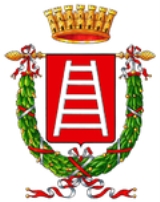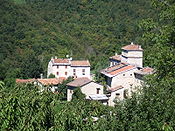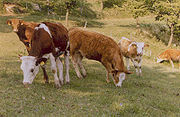
San Rocco di Piegara
Encyclopedia
San Rocco di Piegara is a frazione
of Roverè Veronese
(VR
) which is one of the 13 ancient Cimbrian towns. Piegara has been an autonomous municipality since the 14th century.
protector, during the plague of 1630–31. Piegara, the older toponym, perhaps derives from 'pegara' (a place full of traces left by cows).
, about 6 km northeast of Verona
. Along the way from south to north one meets the villages of Trezzolano and Cancello. From San Rocco continuing along the SP-35 one reaches San Vitale in Arco (4 km), which is also a frazione
of Roverè
, whilst turning east one finds San Mauro di Saline
(5 km).
The altitude at the village square is 640 m AMSL.
, while in 1744 it became an independent parish.
The current church, dedicated to St. Rocco
was constructed at the end of the seventeenth century after a fire destroyed the original structure. It opened for worship in 1875 and was completed in 1911 with a Corinthian
facade. Today it features a central altar from the seventeenth century, four side altars of baroque style and preserves a valuable painting of the Madonna of the Rose painted by Domenico Maccacaro in 1600.
Of great interest is the canvas with St. Charles Borromeo
(kneeling before the crucifix and moving towards the Council of Trento), with an enrollment of 1630, placed between the two altars on the right of the church, painted by Lorenzo Bertafino. The bell tower was built in 1888, although the modern cusp dates to 1952.
 The 'contrade' are the typical districts of the settlement of the Lessini Mountains, consisting of single-family houses with stables and other buildings as the icehouses
The 'contrade' are the typical districts of the settlement of the Lessini Mountains, consisting of single-family houses with stables and other buildings as the icehouses
and the 'baiti', where cheese was made. The building materials were mainly two : the stone
for the exterior and wood for the interior, as these materials are easily found in the surrounding area. Preferably they used to be built in sunny places and sheltered by a hillock. Around the districts there are quite a lot of meadows, which were once cultivated with rye
and, in the lowest areas, with wheat, as well as numerous fruit trees, such as sour cherry
, walnut
, and in the lowest districts, even wild apple
and pear trees; these trees, planted in regular rows, used to demarcate the boundaries of a property. Today the 'contrade' are connected with each other through streets, but once the steps were possible only by mule tracks or paths, allowing the transit of wagons.
 Worthy of note is the production of hiking boots and mountaineering footwear
Worthy of note is the production of hiking boots and mountaineering footwear
, entrusted to three factories of different dimensions: an ancient art wisely handed on until the advent of modern technology applied also to stylistic choices equally innovative and sophisticated materials which are constantly evolving. Considered to be important activities are those related to the building industry: civil and road construction and earthmoving companies and others of craftmen such as masons, carpenters, painters, electricians and plumbers.
Agriculture consists not only in traditional products such as chestnuts or cherries but also in new crops and innovative techniques such as strawberries in hydroponic cultivation
. The abundant presence of flowering lawns and fruit trees promotes beekeeping
and honey
production.
The cattle is intended mainly for the production of milk, but some farmers have recently embarked on the sales activities of organic meat
.
The hilly position of the village and its vocation to summer holiday spot allowed the nearby places a development in tourism (hotels, restaurants, 'agriturismi
').
 The ancient feast of Maroni
The ancient feast of Maroni
(chestnuts) is held annually in San Rocco di Piegara in the penultimate Sunday of October. Autumn welcomes the return of chestnuts and the village is full of people, inviting scents and colored stalls packed with local products.
In the main square, a giant "rostidora" cooks quintals of maroni, while enogastronomical stands offer tastings of wine and home-made food. At the celebration, skilled craftsmen offer demonstrations of crafts of ancient culture, such as timber and the production of baskets, with musical accompaniment in the background.
It is celebrated on 16 August and the residents of Roverè follow a procession through the streets of the district.
An event that is held every year at the penultimate Sunday of October, with the tradition of the tasting of the most characteristical and appetizing fruit found on the Veronese mountain.
People of the district form conical heaps made of dry twig and chopped-off branches and they burn them on the evening of the 6 January. Above the bonfire a puppet, representing an old witch, hence the name, may be hung.
On 4 November, blessed bread is distributed to the population.
Frazione
A frazione , in Italy, is the name given in administrative law to a type of territorial subdivision of a comune; for other administrative divisions, see municipio, circoscrizione, quartiere...
of Roverè Veronese
Roverè Veronese
Roverè Veronese is a comune in the Province of Verona in the Italian region Veneto, located about 100 km west of Venice and about 20 km northeast of Verona...
(VR
Province of Verona
The Province of Verona is a province in the Veneto region of Italy. Its capital is the city of Verona.-Overview:The province has an area of 3,109 km², and a total population of 912,981...
) which is one of the 13 ancient Cimbrian towns. Piegara has been an autonomous municipality since the 14th century.
Etymology and history
The name San Rocco (Saint Roch) comes from a vote made by the population to the saint of Montpellier (who lived in the first half of fourteenth century), who is the plagueBubonic plague
Plague is a deadly infectious disease that is caused by the enterobacteria Yersinia pestis, named after the French-Swiss bacteriologist Alexandre Yersin. Primarily carried by rodents and spread to humans via fleas, the disease is notorious throughout history, due to the unrivaled scale of death...
protector, during the plague of 1630–31. Piegara, the older toponym, perhaps derives from 'pegara' (a place full of traces left by cows).
Geography
The village of San Rocco di Piegara lies on the lower Lessini Mountains, on the ridge between the Squaranto valley and the Mezzane valley, in a quite flat area where you can see the typical landscape of Lessinia. It can be reached through the provincial road SP-35 that begins in MontorioMontorio
Montorio may refer to:*Montorio al Vomano, a town in the province of Teramo, Italy*Montorio nei Frentani, a town in the province of Campobasso, Italy*Montorio Romano, a town in the province of Rome, Italy*Montorio, Burgos, a municipality in Spain...
, about 6 km northeast of Verona
Verona
Verona ; German Bern, Dietrichsbern or Welschbern) is a city in the Veneto, northern Italy, with approx. 265,000 inhabitants and one of the seven chef-lieus of the region. It is the second largest city municipality in the region and the third of North-Eastern Italy. The metropolitan area of Verona...
. Along the way from south to north one meets the villages of Trezzolano and Cancello. From San Rocco continuing along the SP-35 one reaches San Vitale in Arco (4 km), which is also a frazione
Frazione
A frazione , in Italy, is the name given in administrative law to a type of territorial subdivision of a comune; for other administrative divisions, see municipio, circoscrizione, quartiere...
of Roverè
Roverè Veronese
Roverè Veronese is a comune in the Province of Verona in the Italian region Veneto, located about 100 km west of Venice and about 20 km northeast of Verona...
, whilst turning east one finds San Mauro di Saline
San Mauro di Saline
San Mauro di Saline is a comune in the Province of Verona in the Italian region Veneto, located about 90 km west of Venice and about 20 km northeast of Verona...
(5 km).
The altitude at the village square is 640 m AMSL.
The Parish Church
The first chapel built by the Counts Azzini dates back to the seventeenth century, although an earlier church may have preceded it. In the first half of the seventeenth century Piegara became independent from Cancello and subjected to the parish of RoverèRoverè Veronese
Roverè Veronese is a comune in the Province of Verona in the Italian region Veneto, located about 100 km west of Venice and about 20 km northeast of Verona...
, while in 1744 it became an independent parish.
The current church, dedicated to St. Rocco
Roch
Saint Roch or Rocco ; lived c.1348 - 15/16 August 1376/79 was a Christian saint, a confessor whose death is commemorated on 16 August; he is specially invoked against the plague...
was constructed at the end of the seventeenth century after a fire destroyed the original structure. It opened for worship in 1875 and was completed in 1911 with a Corinthian
Corinthian order
The Corinthian order is one of the three principal classical orders of ancient Greek and Roman architecture. The other two are the Doric and Ionic. When classical architecture was revived during the Renaissance, two more orders were added to the canon, the Tuscan order and the Composite order...
facade. Today it features a central altar from the seventeenth century, four side altars of baroque style and preserves a valuable painting of the Madonna of the Rose painted by Domenico Maccacaro in 1600.
Of great interest is the canvas with St. Charles Borromeo
Charles Borromeo
Charles Borromeo was the cardinal archbishop of the Catholic Archdiocese of Milan from 1564 to 1584. He was a leading figure during the Counter-Reformation and was responsible for significant reforms in the Catholic Church, including the founding of seminaries for the education of priests...
(kneeling before the crucifix and moving towards the Council of Trento), with an enrollment of 1630, placed between the two altars on the right of the church, painted by Lorenzo Bertafino. The bell tower was built in 1888, although the modern cusp dates to 1952.
The 'Contrade'

Icehouse (building)
Ice houses were buildings used to store ice throughout the year, prior to the invention of the refrigerator. Some were underground chambers, usually man-made, close to natural sources of winter ice such as freshwater lakes, but many were buildings with various types of insulation.During the...
and the 'baiti', where cheese was made. The building materials were mainly two : the stone
Dimension stone
Dimension stone is natural stone or rock that has been selected and fabricated to specific sizes or shapes. Color, texture and pattern, and surface finish of the stone are also normal requirements...
for the exterior and wood for the interior, as these materials are easily found in the surrounding area. Preferably they used to be built in sunny places and sheltered by a hillock. Around the districts there are quite a lot of meadows, which were once cultivated with rye
Rye
Rye is a grass grown extensively as a grain and as a forage crop. It is a member of the wheat tribe and is closely related to barley and wheat. Rye grain is used for flour, rye bread, rye beer, some whiskeys, some vodkas, and animal fodder...
and, in the lowest areas, with wheat, as well as numerous fruit trees, such as sour cherry
Sour Cherry
Prunus cerasus, or the sour cherry, is a species of Prunus in the subgenus Cerasus , native to much of Europe and southwest Asia. It is closely related to the wild cherry Prunus cerasus, or the sour cherry, is a species of Prunus in the subgenus Cerasus (cherries), native to much of Europe and...
, walnut
Walnut
Juglans is a plant genus of the family Juglandaceae, the seeds of which are known as walnuts. They are deciduous trees, 10–40 meters tall , with pinnate leaves 200–900 millimetres long , with 5–25 leaflets; the shoots have chambered pith, a character shared with the wingnuts , but not the hickories...
, and in the lowest districts, even wild apple
Malus sylvestris
Malus sylvestris, the European wild apple, is a species of Malus , native to Europe from as far south as Spain, Italy and Greece to as far north as Scandinavia and Russia. Its scientific name means "forest apple", and the truly wild tree has thorns.In the past, M. sylvestris was thought to be an...
and pear trees; these trees, planted in regular rows, used to demarcate the boundaries of a property. Today the 'contrade' are connected with each other through streets, but once the steps were possible only by mule tracks or paths, allowing the transit of wagons.
Economy

Mountaineering boots
Mountaineering boots are a type of footwear used in the sport of mountain climbing. They are designed specifically for moving over harsh terrain.-Design:Not to be confused with hiking boots, mountaineering boots are usually taller, stiffer, and insulated...
, entrusted to three factories of different dimensions: an ancient art wisely handed on until the advent of modern technology applied also to stylistic choices equally innovative and sophisticated materials which are constantly evolving. Considered to be important activities are those related to the building industry: civil and road construction and earthmoving companies and others of craftmen such as masons, carpenters, painters, electricians and plumbers.
Agriculture consists not only in traditional products such as chestnuts or cherries but also in new crops and innovative techniques such as strawberries in hydroponic cultivation
Hydroponics
Hydroponics is a method of growing plants using mineral nutrient solutions, in water, without soil. Terrestrial plants may be grown with their roots in the mineral nutrient solution only or in an inert medium, such as perlite, gravel, mineral wool, or coconut husk.Researchers discovered in the 18th...
. The abundant presence of flowering lawns and fruit trees promotes beekeeping
Beekeeping
Beekeeping is the maintenance of honey bee colonies, commonly in hives, by humans. A beekeeper keeps bees in order to collect honey and other products of the hive , to pollinate crops, or to produce bees for sale to other beekeepers...
and honey
Honey
Honey is a sweet food made by bees using nectar from flowers. The variety produced by honey bees is the one most commonly referred to and is the type of honey collected by beekeepers and consumed by humans...
production.
The cattle is intended mainly for the production of milk, but some farmers have recently embarked on the sales activities of organic meat
Organic food
Organic foods are foods that are produced using methods that do not involve modern synthetic inputs such as synthetic pesticides and chemical fertilizers, do not contain genetically modified organisms, and are not processed using irradiation, industrial solvents, or chemical food additives.For the...
.
The hilly position of the village and its vocation to summer holiday spot allowed the nearby places a development in tourism (hotels, restaurants, 'agriturismi
Agritourism
Agritourism, as it is defined most broadly, involves any agriculturally-based operation or activity that brings visitors to a farm or ranch. Agritourism has different definitions in different parts of the world, and sometimes refers specifically to farm stays, as in Italy...
').
The Maroni Feast

Chestnut
Chestnut , some species called chinkapin or chinquapin, is a genus of eight or nine species of deciduous trees and shrubs in the beech family Fagaceae, native to temperate regions of the Northern Hemisphere. The name also refers to the edible nuts they produce.-Species:The chestnut belongs to the...
(chestnuts) is held annually in San Rocco di Piegara in the penultimate Sunday of October. Autumn welcomes the return of chestnuts and the village is full of people, inviting scents and colored stalls packed with local products.
In the main square, a giant "rostidora" cooks quintals of maroni, while enogastronomical stands offer tastings of wine and home-made food. At the celebration, skilled craftsmen offer demonstrations of crafts of ancient culture, such as timber and the production of baskets, with musical accompaniment in the background.
Traditional annual events
- Feast of the Patron (San Rocco)
It is celebrated on 16 August and the residents of Roverè follow a procession through the streets of the district.
- Feast of 'Maroni'
An event that is held every year at the penultimate Sunday of October, with the tradition of the tasting of the most characteristical and appetizing fruit found on the Veronese mountain.
- Epiphany, "brusàr la vecia" (to burn the witch)
People of the district form conical heaps made of dry twig and chopped-off branches and they burn them on the evening of the 6 January. Above the bonfire a puppet, representing an old witch, hence the name, may be hung.
- St. Charles Borromeo, the "bread of the poor"
On 4 November, blessed bread is distributed to the population.

